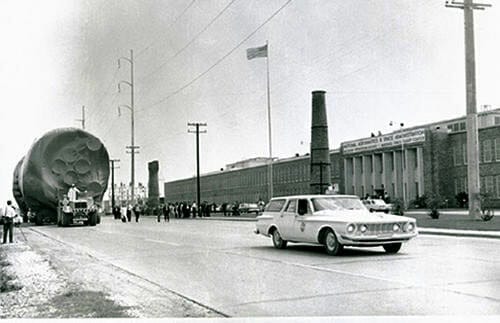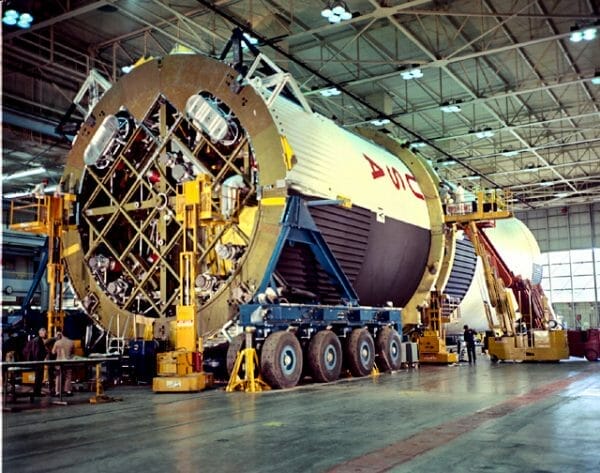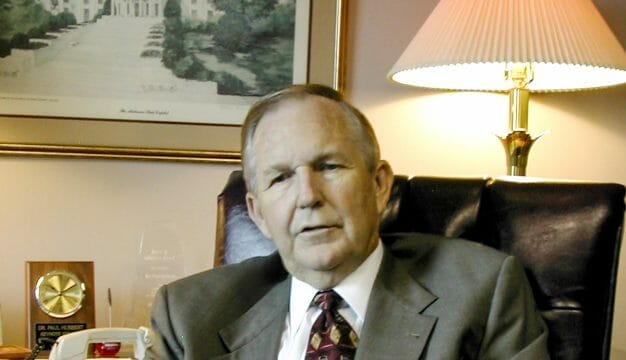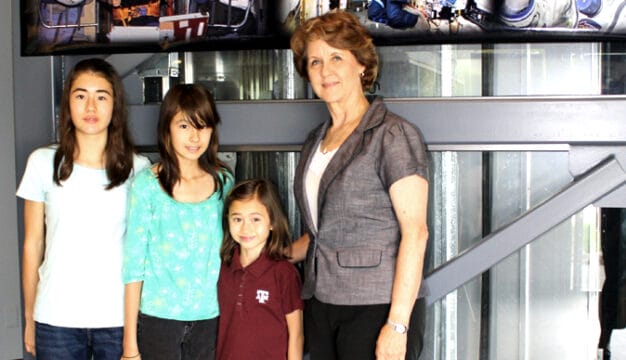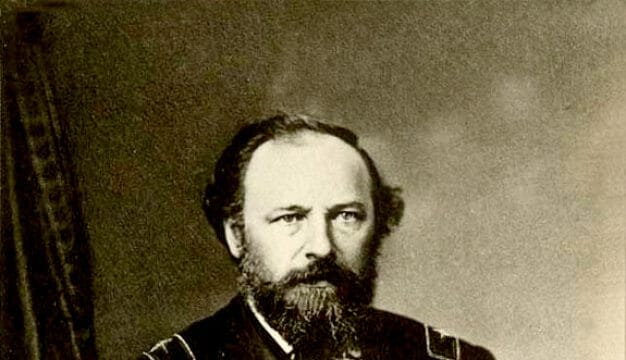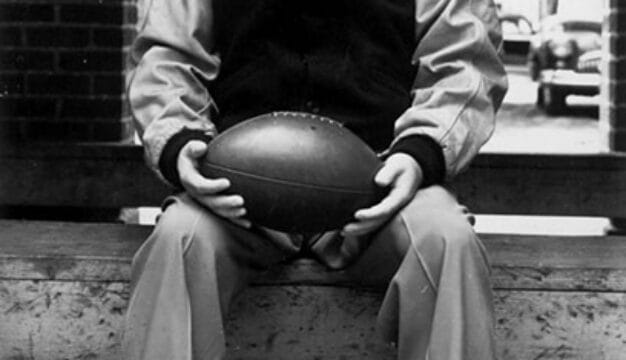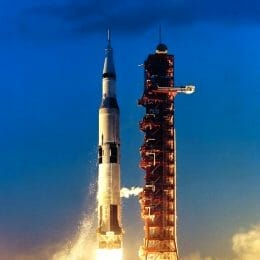Marshall Space Flight Center
 Saturn V
George C. Marshall Space Flight Center (MSFC) has been the heart of the U.S. space program since its beginnings in the 1960s. The center provided the rockets that took the first man to the Moon, developed the first space station (Skylab), and has been an integral part of the programs that oversee the Hubble Space Telescope and the Shuttle Program. MSFC has also played a role in making its home city of Huntsville, Madison County, one of the most socially and economically progressive cities in the South.
Saturn V
George C. Marshall Space Flight Center (MSFC) has been the heart of the U.S. space program since its beginnings in the 1960s. The center provided the rockets that took the first man to the Moon, developed the first space station (Skylab), and has been an integral part of the programs that oversee the Hubble Space Telescope and the Shuttle Program. MSFC has also played a role in making its home city of Huntsville, Madison County, one of the most socially and economically progressive cities in the South.
Located in north-central Alabama, the center is named for George C. Marshall, the U.S. Army’s World War II chief of staff and the creator of the Marshall Plan. MSFC shares land with Redstone Arsenal, having originally been an army rocket development facility within Redstone called the Army Ballistic Missile Agency (ABMA). On July 1, 1960, less than two years after the establishment of the National Aeronautics and Space Administration (NASA), ABMA became a field center connected with NASA, with German rocket expert Wernher von Braun as its first director. Von Braun, who oversaw development of the German military’s V-2 rocket program, put together a team consisting of young American engineers from throughout the South and about 100 fellow German expatriates. In the 1950s, while still assigned to the army at the Redstone Arsenal, they developed the Jupiter C rocket that launched Explorer I, the first American satellite, in January 1958.
The 1960s were NASA’s boom years, and Marshall was designated as the agency’s propulsion center, developing the rockets that would launch NASA’s missions into space. MSFC helped make history in 1961 when its Mercury-Redstone rocket powered Alan B. Shepard into suborbital flight, making him the first American in space. Marshall’s major task during the 1960s was the development of the Saturn rockets that were used in the Apollo moon missions. They aimed to fulfill President John F. Kennedy’s challenge to NASA to execute a moon landing by the end of the decade.
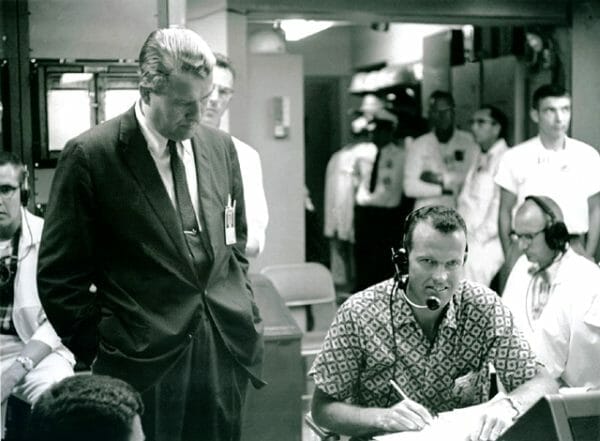 Wernher von Braun and Astronaut L. Gordon Cooper
The Saturn V, the culmination of the Saturn series, was one of the technological marvels of the space age. Its first stage alone incorporated a cluster of five engines, each of which generated 1.5 million pounds of thrust. Marshall engineers performed many of the tests of the Saturn engines on enormous test stands on the south end of the center; the tests produced a deafening roar that shook the city of Huntsville. Saturn V rockets powered each of the 13 Apollo missions launched between 1967 and 1973, including the first Moon landing on July 20, 1969. On the last three Apollo missions in 1971 and 1972, astronauts explored the lunar surface in a lunar roving vehicle (LRV) designed at Marshall.
Wernher von Braun and Astronaut L. Gordon Cooper
The Saturn V, the culmination of the Saturn series, was one of the technological marvels of the space age. Its first stage alone incorporated a cluster of five engines, each of which generated 1.5 million pounds of thrust. Marshall engineers performed many of the tests of the Saturn engines on enormous test stands on the south end of the center; the tests produced a deafening roar that shook the city of Huntsville. Saturn V rockets powered each of the 13 Apollo missions launched between 1967 and 1973, including the first Moon landing on July 20, 1969. On the last three Apollo missions in 1971 and 1972, astronauts explored the lunar surface in a lunar roving vehicle (LRV) designed at Marshall.
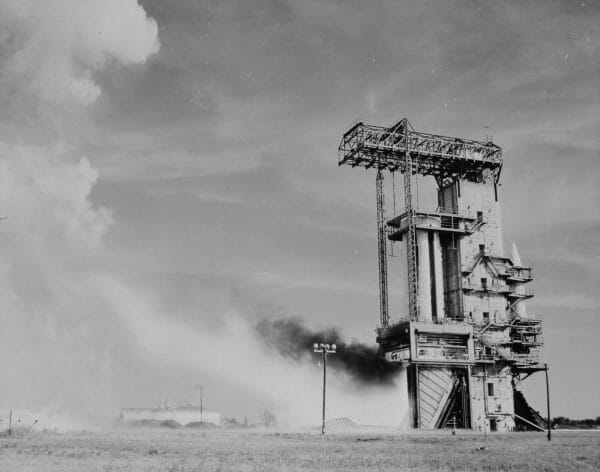 Static Firing in Test Stand at MSFC, 1960
Marshall’s extraordinary technological achievements often overshadowed the sociopolitical gains brought to Huntsville by the center. In the early 1960s, the federal government threatened to shift Marshall projects to other centers unless Alabama made progress in civil rights, and Marshall’s presence mitigated civil rights problems in north Alabama. And while Gov. George Wallace preached segregation, and Montgomery, Birmingham, and Selma erupted in violence, businessmen in Huntsville sought to preserve federal contracts by avoiding racial strife. The strategy paid off, and Huntsville became a New South success story. High-tech companies proliferated, and the town prospered. Its population doubled during the 1960s to more than 140,000. Despite these successes, questions and concerns lingered about the degree to which von Braun and his German colleagues had sympathized with the Nazi philosophy.
Static Firing in Test Stand at MSFC, 1960
Marshall’s extraordinary technological achievements often overshadowed the sociopolitical gains brought to Huntsville by the center. In the early 1960s, the federal government threatened to shift Marshall projects to other centers unless Alabama made progress in civil rights, and Marshall’s presence mitigated civil rights problems in north Alabama. And while Gov. George Wallace preached segregation, and Montgomery, Birmingham, and Selma erupted in violence, businessmen in Huntsville sought to preserve federal contracts by avoiding racial strife. The strategy paid off, and Huntsville became a New South success story. High-tech companies proliferated, and the town prospered. Its population doubled during the 1960s to more than 140,000. Despite these successes, questions and concerns lingered about the degree to which von Braun and his German colleagues had sympathized with the Nazi philosophy.
In the late 1960s, as Marshall completed Saturn development, the center underwent a painful transition. Reductions-in-force cut into the workforce, and many Germans from the original von Braun team retired or took lesser assignments. In 1970, von Braun left Marshall to take a position at NASA’s Washington, D.C., headquarters.
Under von Braun, the center had begun to explore the possibilities of branching out into fields outside of propulsion. By the early 1970s, Marshall executives realized that propulsion work alone was unlikely to sustain the center, and indeed NASA later considered closing MSFC. During the 1970s and into the early 1980s, the center developed specializations in space science (the scientific exploration of the solar system and beyond), materials research (experiments with semiconductors, glasses and ceramics, metals and alloys, and polymers in the microgravity environment of space), and other fields that soon made Marshall NASA’s most diversified field center.
In 1973, the MSFC helped salvage Skylab, an early attempt at a space station that was made from a refurbished Saturn third-stage rocket. Skylab’s solar panels were damaged during launch on May 14, 1973, and the station began to overheat to dangerous levels when it reached orbit. In a dramatic rescue effort, engineers at Marshall devised a parasol to shield Skylab from solar radiation and realigned the craft. During the next nine months, three three-man crews logged more than 171 days aboard Skylab, demonstrating that humans could adapt to spending long amounts of time in space.
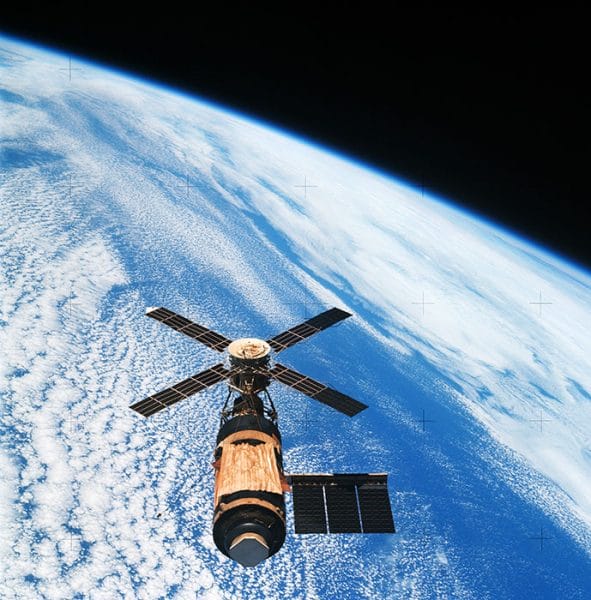 Skylab
In the early 1980s, MSFC researchers led the development of Spacelab, a self-contained portable laboratory that could be fitted into the newly developed fleet of space shuttles. A joint venture between NASA and the European Space Agency (ESA), Spacelab served as an interim step on the way to the development of the International Space Station. Marshall served as NASA’s lead center for Spacelab development, with ESA taking charge of design and development duties. Nestled into the shuttle’s cargo bay, Spacelab carried experiments aloft and allowed astronaut scientists to work out of their space suits. Between 1982 and 1998, Spacelab flew on 28 shuttle missions.
Skylab
In the early 1980s, MSFC researchers led the development of Spacelab, a self-contained portable laboratory that could be fitted into the newly developed fleet of space shuttles. A joint venture between NASA and the European Space Agency (ESA), Spacelab served as an interim step on the way to the development of the International Space Station. Marshall served as NASA’s lead center for Spacelab development, with ESA taking charge of design and development duties. Nestled into the shuttle’s cargo bay, Spacelab carried experiments aloft and allowed astronaut scientists to work out of their space suits. Between 1982 and 1998, Spacelab flew on 28 shuttle missions.
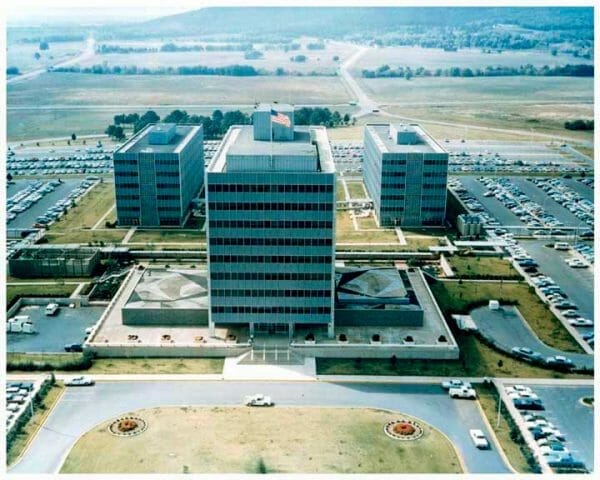 Marshall Space Flight Center, ca. 1960s
Despite broadening its research activities, Marshall continued to serve as NASA’s principal propulsion center. When the space shuttle program was fully approved, NASA assigned Marshall to develop the major propulsion system. Marshall’s duties changed, however, from development to primarily overseeing contractors, reflecting a general trend within NASA to curtail in-house development. As a result, NASA’s workforce declined from a peak of 7,327 in 1965 to less than half that figure by the mid-1990s. At the same time, offices of contractors in Huntsville who found work either at Marshall or for the army at Redstone Arsenal proliferated—from high tech companies begun by local entrepreneurs to representatives of major national aerospace companies. Huntsville established a 3,000-acre research park in 1962, and in 1973 named it in memory of former Brown Engineering CEO Milton K. Cummings. Expansion brought its acreage to 3,843, and it now ranks as the second-largest research park in the United States. In 1979, future astronaut Jan Davis began working as an engineer for Marshall, eventually serving as team leader for several important efforts, including the Hubble Space Telescope. On January 28, 1986, the shuttle Challenger exploded 73 seconds after liftoff. A subsequent investigation by a presidential board (the Rogers Commission) demonstrated that the cause of the explosion was burn-through of O-ring seals on the Solid Rocket Booster (SRB), and because this component was under Marshall’s purview, the investigation focused on the center. Director William R. Lucas and some of his leading assistants resigned in the aftermath, and Marshall faced criticism for pressuring SRB contractor Morton-Thiokol to approve a cold-weather launch. In truth the story was more complicated, and communications issues that highlighted the investigation were only a partial explanation; the O-ring problem was a known risk, one that NASA had accepted. Marshall led the redesign of the SRB, with Davis leading the project focusing on the O-rings, that enabled the shuttle Discovery to return to space flight on September 29, 1988.
Marshall Space Flight Center, ca. 1960s
Despite broadening its research activities, Marshall continued to serve as NASA’s principal propulsion center. When the space shuttle program was fully approved, NASA assigned Marshall to develop the major propulsion system. Marshall’s duties changed, however, from development to primarily overseeing contractors, reflecting a general trend within NASA to curtail in-house development. As a result, NASA’s workforce declined from a peak of 7,327 in 1965 to less than half that figure by the mid-1990s. At the same time, offices of contractors in Huntsville who found work either at Marshall or for the army at Redstone Arsenal proliferated—from high tech companies begun by local entrepreneurs to representatives of major national aerospace companies. Huntsville established a 3,000-acre research park in 1962, and in 1973 named it in memory of former Brown Engineering CEO Milton K. Cummings. Expansion brought its acreage to 3,843, and it now ranks as the second-largest research park in the United States. In 1979, future astronaut Jan Davis began working as an engineer for Marshall, eventually serving as team leader for several important efforts, including the Hubble Space Telescope. On January 28, 1986, the shuttle Challenger exploded 73 seconds after liftoff. A subsequent investigation by a presidential board (the Rogers Commission) demonstrated that the cause of the explosion was burn-through of O-ring seals on the Solid Rocket Booster (SRB), and because this component was under Marshall’s purview, the investigation focused on the center. Director William R. Lucas and some of his leading assistants resigned in the aftermath, and Marshall faced criticism for pressuring SRB contractor Morton-Thiokol to approve a cold-weather launch. In truth the story was more complicated, and communications issues that highlighted the investigation were only a partial explanation; the O-ring problem was a known risk, one that NASA had accepted. Marshall led the redesign of the SRB, with Davis leading the project focusing on the O-rings, that enabled the shuttle Discovery to return to space flight on September 29, 1988.
Marshall also endured criticism for its performance as the lead center in the development of the Hubble Space Telescope, a shuttle-launched instrument that could penetrate deep space without interference from Earth’s atmosphere. Soon after launch in April 1990, scientists encountered a problem generated by a malfunction of the equipment used to polish Hubble’s mirror; the telescope’s vision was flawed. Adjustments and repairs made to Hubble during a Space Shuttle Endeavour mission in 1993 restored its sight, and Hubble produced astonishing images from distant galaxies. That Shuttle mission included Alabama astronaut Kathryn Thornton, a native of Montgomery.
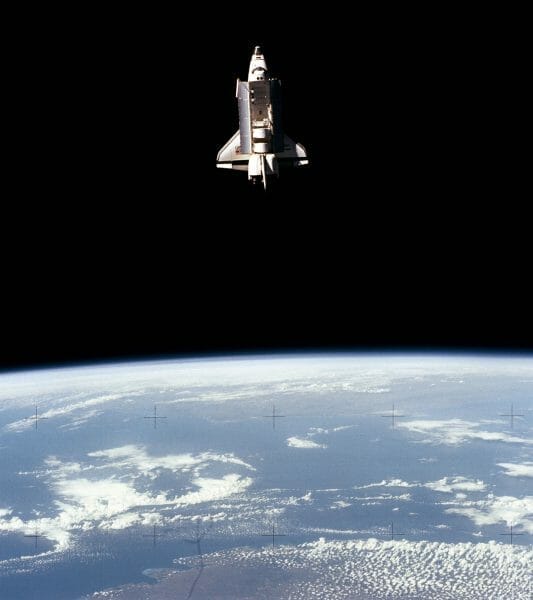 Challenger in Orbit
In recent years, Marshall’s diversification has paid off. The center played an important role in the development of the International Space Station and in directing its science operations. MSFC became NASA’s lead center for microgravity research and remained prominent in investigations of advanced propulsion technology. Marshall’s role in space science has expanded with such projects as the Chandra X-ray Observatory and Gravity Probe B, which aims to test Einstein’s theories about the structure of the universe. In 2011, Marshall began development of the Space Launch Systems initiative, which will provide next-generation propulsion for manned missions to other parts of Earth’s Solar System. Even in an era of tight budgets, such projects allowed Alabama political leaders and business interests to fend off attempts to reduce MSFC’s role and have enabled administrators to negotiate new work as the center upgrades its facilities.
Challenger in Orbit
In recent years, Marshall’s diversification has paid off. The center played an important role in the development of the International Space Station and in directing its science operations. MSFC became NASA’s lead center for microgravity research and remained prominent in investigations of advanced propulsion technology. Marshall’s role in space science has expanded with such projects as the Chandra X-ray Observatory and Gravity Probe B, which aims to test Einstein’s theories about the structure of the universe. In 2011, Marshall began development of the Space Launch Systems initiative, which will provide next-generation propulsion for manned missions to other parts of Earth’s Solar System. Even in an era of tight budgets, such projects allowed Alabama political leaders and business interests to fend off attempts to reduce MSFC’s role and have enabled administrators to negotiate new work as the center upgrades its facilities.
Further Reading
- Bilstein, Roger E. Stages to Saturn: A Technological History of the Apollo/Saturn Launch Vehicles. Washington, D.C.: Scientific and Technical Information Branch, National Aeronautics and Space Administration, 1980.
- Dunar, Andrew J., and Stephen P. Waring. Power to Explore: A History of Marshall Space Flight Center, 1960-1990. Washington, D.C.: Scientific and Technical Information Branch, National Aeronautics and Space Administration, 1999.
- Stuhlinger, Ernst, and Frederick I. Ordway. Wernher von Braun, Crusader for Space: A Biographical Memoir. Malabar, Fla.: Krieger Publishing Company, 1994.
